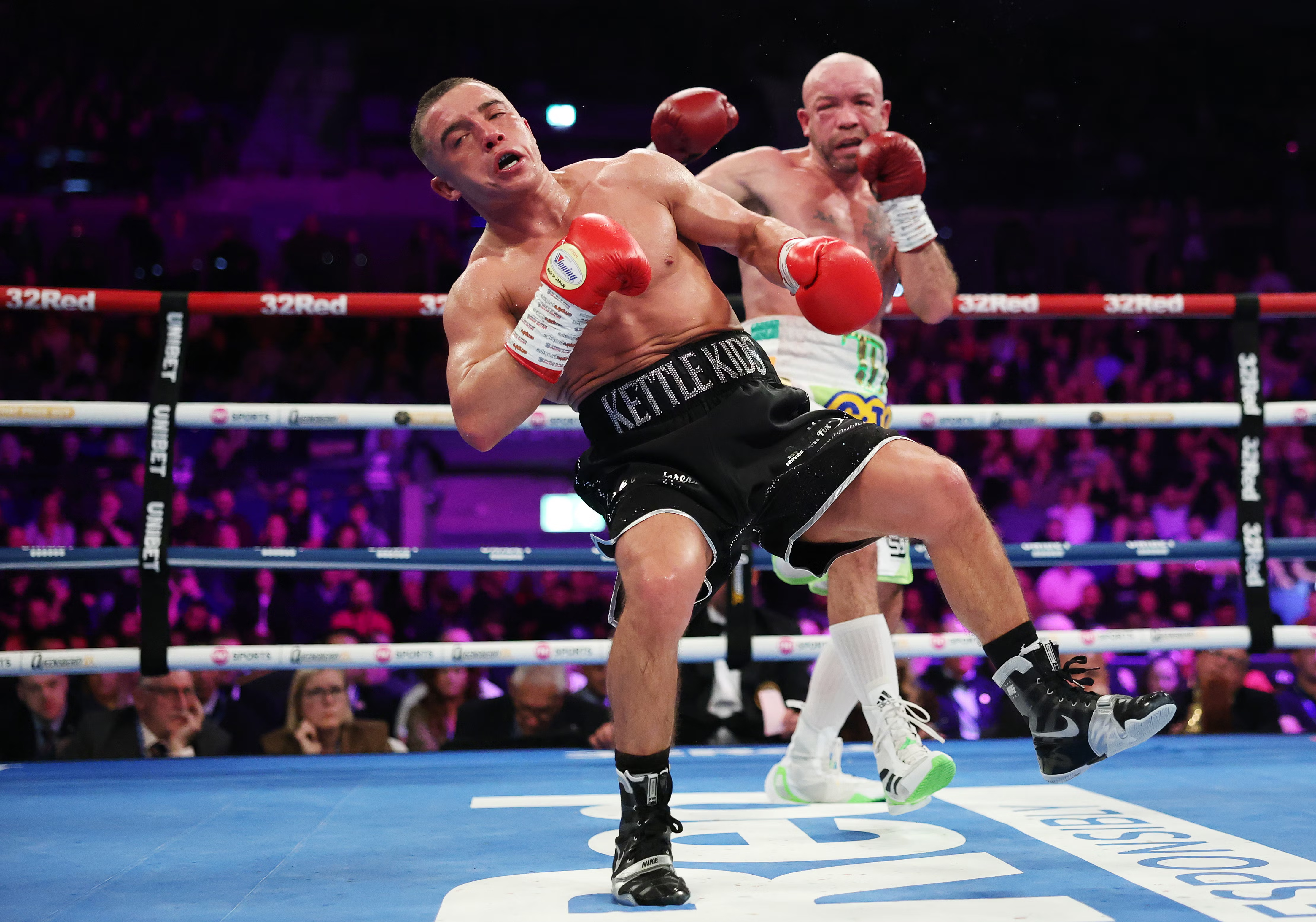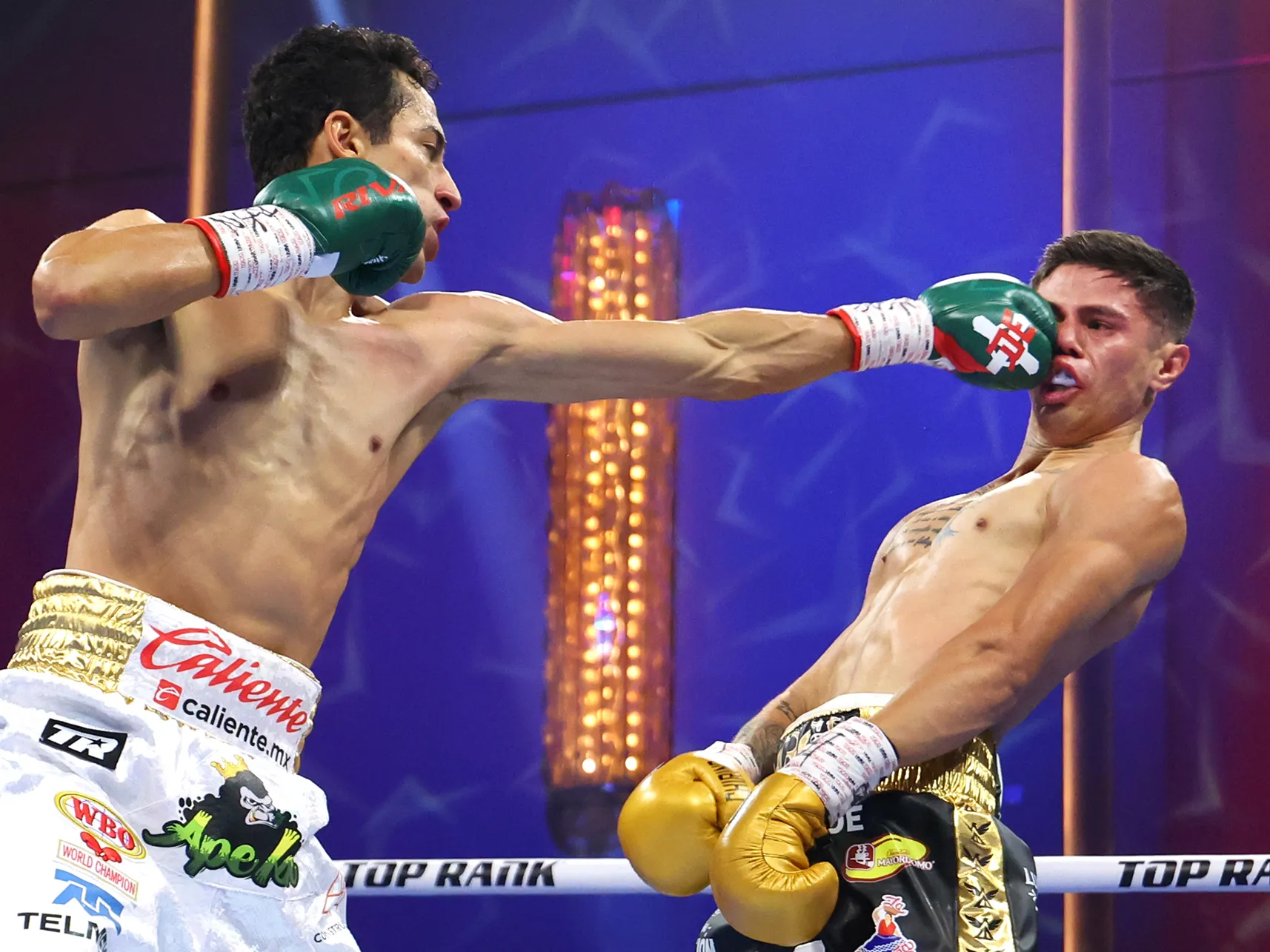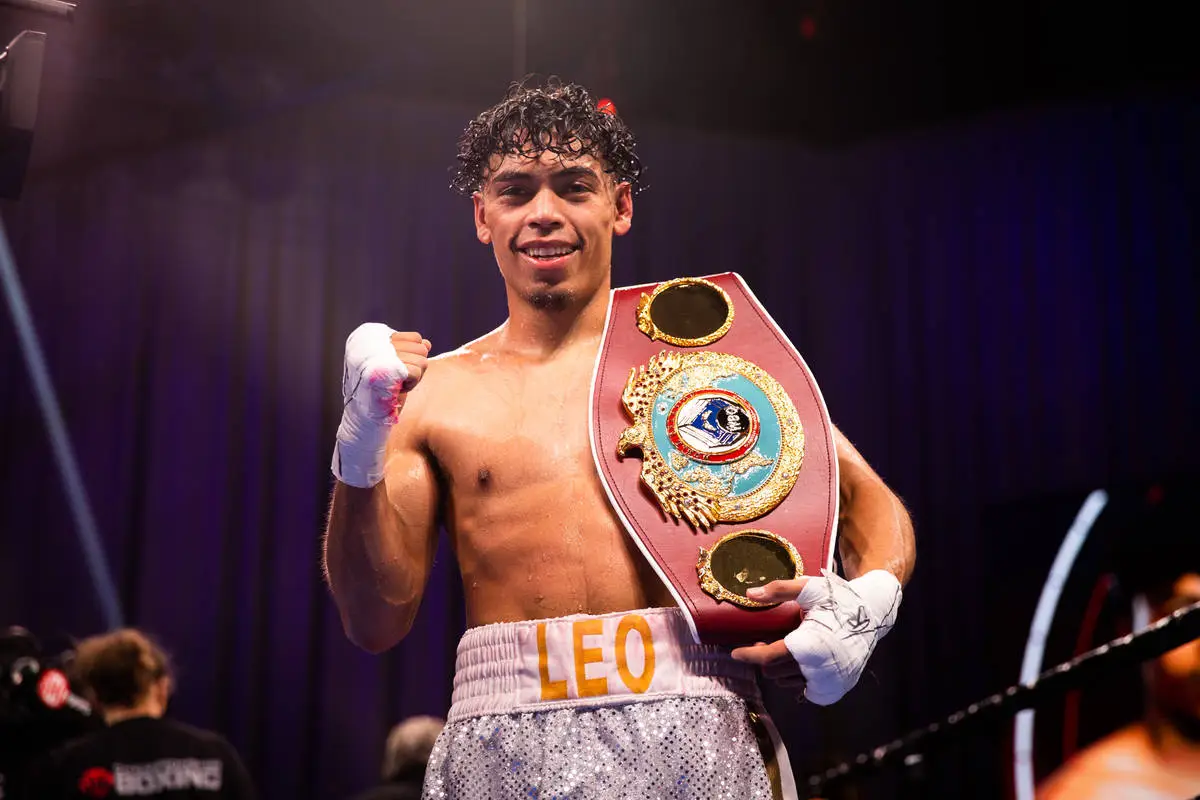Quién de los campeones de peso superpluma recibe más golpes: Ball, Espinoza, Fulton o Leo
15 Aug
El 16 de agosto en Riad, Arabia Saudita se llevará a cabo el combate entre el campeón de la WBA en peso superpluma (hasta 57,15 kg) el británico de 28 años Nick Ball y el australiano de 26 años Sam Goodman. Este combate es un eco de un posible enfrentamiento entre Ball e Inoue del cual se hablaba activamente no hace mucho. Goodman fue contendiente contra Naoya pero no pudo subir al ring debido a una cortadura que se recidivó después de un tiempo.
Al mismo tiempo, la categoría de peso superpluma está llena de campeones impresionantes, cada uno con un estilo de pelea completamente diferente. Ball definitivamente tiene trabajo por hacer en su categoría contra los campeones actuales. Hoy los hemos comparado en base a un solo indicador: los golpes recibidos.
Actualmente, los títulos en la categoría de peso superpluma están en manos de Nick Ball (WBA), Rafael Espinoza (WBO), Stephen Fulton (WBC) y Angelo Leo (IBF). Cuatro boxeadores con estilos completamente diferentes. Cuatro atletas que incluso varían en tamaño: la altura de Ball es de 157 cm, mientras que Espinoza mide 185 cm.
A partir de esto y también considerando la alta precisión de Sam Goodman, de la cual hablamos en un análisis detallado de su combate contra Nick, aquí mostramos cuántos golpes reciben estos campeones. Los jueces profesionales de Ready to Fight calcularon las estadísticas de los golpes en los últimos dos combates de cada uno de los poseedores de los títulos. El equipo de analistas recopiló estos datos en cifras finales y aquí explicamos lo que significan.
Espinoza tiene el mayor porcentaje de golpes recibidos. Ball está justo detrás de él
El estilo de pelea lo dicta todo. A veces, los boxeadores cambian su enfoque. En su mayoría, boxeando de manera ofensiva, algunos se adaptan y pasan a contragolpear. O, al contrario, avanzan hacia adelante, aunque generalmente han trabajado desde la retaguardia.
Pero son excepciones raras. En su mayoría, estos cambios son impulsados por situaciones en las que el oponente obliga al boxeador a actuar de esa manera.
En el caso de los campeones de peso superpluma, vemos a dos agresores claros: Rafael Espinoza y Nick Ball. Ambos son boxeadores cuya estrategia se basa únicamente en la ofensiva y esto trae las consecuencias correspondientes. Primero: cada uno de sus oponentes se ve obligado a retroceder. Segundo: regularmente reciben una gran cantidad de golpes.
El líder en golpes recibidos entre los campeones actuales es Espinoza. En promedio, en sus últimos dos combates, recibió el 39,5% de los golpes de sus oponentes. Un porcentaje considerable, especialmente si consideramos que uno de los oponentes fue el dos veces campeón olímpico Robeisy Ramírez, quien conectó el 44% de sus golpes.
En ambos casos, Rafael salió victorioso. Además, lo hizo de forma anticipada, antes de los rounds de campeonato. A Vázquez (quien conectó el 38% de sus golpes) lo noqueó en el 6º round y a Ramírez en el 7º.

En segundo lugar está Nick Ball. Sus oponentes conectaron el 31,9% de sus golpes. Sin duda, el estilo ofensivo del británico contribuye a este porcentaje. En promedio, Nick lanza más de 600 golpes por pelea, siempre está atacando y presionando a sus oponentes. Al pelear así, es imposible no recibir contragolpes.
Sin embargo, esto no impidió que Ball consiguiera dos victorias claras contra TJ Doheny y Ronny Rios.
Esto también es relevante en el enfrentamiento entre Ball y Goodman. Sam es muy preciso. Su promedio de golpes conectados en los últimos combates fue del 38%.
Angelo Leo y Stephen Fulton son notablemente más hábiles en defensa. Ninguno de los dos es tan arriesgado en ataque como sus compañeros campeones.
El más habilidoso en este aspecto es Fulton. Recibió, en promedio, el 23,9% de los golpes de sus oponentes en los dos últimos combates. El porcentaje de Leo es algo peor pero no significativamente: 24,6%.
La diferencia mínima entre Fulton, Leo y Ball con respecto a Espinoza es de 7,3%. Esto una vez más resalta la diversidad de estilos entre los campeonatos de peso superpluma.
En términos absolutos, Espinoza recibe menos golpes pero Ball sigue estando en la cima
El porcentaje de golpes recibidos es importante. Muestra, en promedio, cuántos golpes recibe un boxeador, independientemente del oponente. Si analizamos estos números en perspectiva, podemos deducir cuántos golpes aproximadamente conectará su adversario. Además, nos ayuda a saber si un boxeador debe o no cambiar su estilo.
Sin embargo, es igualmente interesante ver estos números desde la perspectiva de la cantidad total. Y aquí la situación cambia un poco.
En general, Fulton es quien recibe más golpes, a pesar de tener el porcentaje más bajo de golpes recibidos. Esto no es una contradicción. Es que sus dos últimos oponentes realmente lanzaron una gran cantidad de golpes. Tanto Castro como Figueroa lanzaron más de 600 golpes por pelea. Stephen recibió en promedio 155 golpes por combate. Esto equivale a más de 7 golpes por round.
Se podría pensar que Espinoza y Ball deberían estar en la cima, ya que sus estilos dictan esto. Pero no es así. El segundo lugar lo ocupa Nick, quien recibió 141 golpes por pelea en los últimos dos combates. Mientras que Rafael es el último entre los campeones, con 88 golpes recibidos. Incluso el más cauteloso Angelo Leo recibe más golpes, con un promedio de 114 golpes por pelea.
Si desglosamos esto en términos de golpes por round, los números son los siguientes:
– Nick Ball: 7,05 golpes recibidos por round (en los últimos dos combates, peleó 20 rounds)
– Stephen Fulton: 7,04 golpes recibidos por round (en los últimos dos combates, peleó 22 rounds)
– Rafael Espinoza: 6,7 golpes recibidos por round (en los últimos dos combates, peleó 13 rounds)
– Angelo Leo: 5,1 golpes recibidos por round (en los últimos dos combates, peleó 22 rounds)

A partir de los números fríos, llegamos a la conclusión respaldada por hechos: Nick Ball es quien recibe más golpes entre los campeones de peso superpluma. No más pero sí con mayor frecuencia. Tiene el mayor porcentaje de golpes recibidos por round y uno de los porcentajes más altos de golpes conectados.
Si comparamos la cantidad de golpes lanzados por los oponentes, en los últimos dos combates, hacia Nick fueron lanzados en promedio 441,5 golpes. Hacia Fulton, se lanzaron 648 golpes. La diferencia es de 206,5 golpes.
Stephen peleó 2 rounds más pero en promedio, recibió menos golpes por round. Incluso un boxeador con un estilo de ataque destacado como Rafael Espinoza no permite que lo golpeen tan frecuentemente como Ball. Pero aquí los tamaños son clave: el mexicano es mucho más grande que cualquier oponente, por lo que tiene un factor natural que le da ventaja.
Es interesante también el porcentaje de golpes fuertes recibidos en relación con el promedio de aciertos de los campeones.
El top de golpes fuertes recibidos se ve igual. En promedio, en los últimos dos combates, los campeones recibieron los golpes en la siguiente proporción:
– Stephen Fulton 107 golpes
– Nick Ball 105,5
– Angelo Leo 95,5
– Rafael Espinoza 68,5
La precisión de los golpes fuertes de los rivales hacia los poseedores de los títulos de la categoría de peso superpluma se distribuye de la siguiente manera:
– Rafael Espinoza 45%
– Nick Ball 35,5%
– Angelo Leo 30%
– Stephen Fulton 30%
De nuevo, con la misma cantidad mencionada anteriormente, Nick está en el top de golpes recibidos. Solo que esta vez, se trata de golpes fuertes.
¿Hace esto a Ball un mal boxeador? Definitivamente no. Sabe cómo ganar y usar sus fortalezas para que el oponente pierda. Eso es lo más importante.
Sin embargo, esto abre más posibilidades para la oposición. Cuando un boxeador recibe golpes con tanta frecuencia (hablando de la frecuencia y no solo de la cantidad) esto crea más oportunidades para que el oponente logre dar el golpe decisivo. O bien, puede golpear más veces, lo que daña al campeón y puede llevarlo a la derrota. Esto aumenta la probabilidad de que el rival con una buena puntería gane.
Ball es quien más recibe golpes en el torso
Para entender las fortalezas y debilidades, es importante analizar las áreas en las que un boxeador recibe más golpes. Con datos claros, no solo observación visual, se pueden corregir errores y también planificar un enfrentamiento contra un boxeador en específico.
Así, la precisión promedio de los ataques a la cabeza de Stephen Fulton es de 74,5%. Este es el porcentaje de todos los golpes acertados que llegaron al estadounidense. Y este es el porcentaje más alto entre todos los campeones. En el torso, solo llega al 25,85%. Considerando la movilidad de Stephen, los ataques a su abdomen serían lógicos pero él rara vez los permite.
En segundo lugar está Angelo Leo, con un 65,15% de golpes que llegaron a su cabeza en los últimos dos combates. En el torso, el 34,85%. El tercero es Rafael Espinoza. Esto se debe, en parte, a sus dimensiones y su alto bloqueo, lo que hace difícil alcanzar su cabeza, por lo que el número total de precisión es del 62,3%. El 37,7% de los golpes llegaron a su torso en sus últimos dos combates.

Ball tiene una mejor defensa en la cabeza. Nick tiene una excelente defensa en el torso y un bloqueo muy sólido, lo cual es importante dado su tamaño y estilo. Pero el torso es la zona que más sufre. La distribución de golpes recibidos en su cuerpo es la siguiente:
– 47,85% de los golpes acertados fueron a la cabeza
– 52,15% de los golpes acertados fueron al torso
A partir de estos números, el combate contra Goodman se vuelve aún más interesante. De hecho, Sam en promedio conecta el 40% de sus golpes fuertes y más de 180 golpes al torso.
Itauma vs. Whyte: transmisión y cartelera
Foto: The Independent, The Tennessean, ESPN, Las Vegas Review-Journal